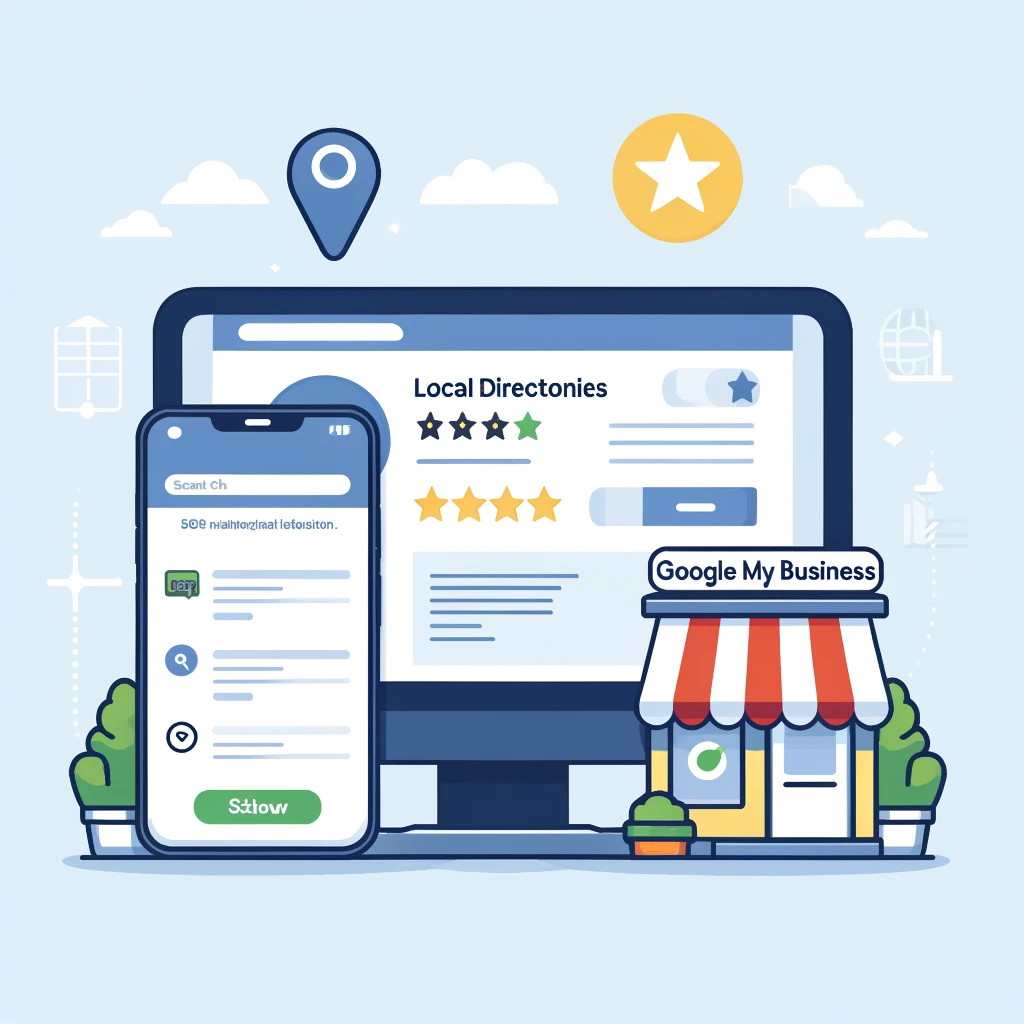Introduction

Welcome to the digital age, where having a strong online presence is not just beneficial for small businesses in Columbia—it’s essential. As more consumers turn to the internet to find products and services, local businesses that can effectively navigate the online world stand to gain significantly. Whether you’re crafting handmade goods, running a local café, or offering professional services, establishing a solid digital footprint can transform your business.
Why Go Online?
- Reach More Customers: The internet breaks down geographical barriers, allowing you to reach customers far beyond your immediate locale.
- Enhanced Customer Interaction: Online platforms offer numerous ways to interact with customers—be it through social media, emails, or your website.
- Operational Efficiency: Many business processes can be automated and streamlined through online tools, saving you time and resources.
- Data Insights: Digital tools provide valuable data that can help you understand customer behavior and tailor your offerings accordingly.
Here’s a glimpse at how small businesses in Columbia are increasingly going digital:
| Year | % of Businesses Online |
|---|---|
| 2018 | 50% |
| 2019 | 58% |
| 2020 | 67% |
| 2021 | 76% |
| 2022 | 84% |
As the trend grows, the importance of adapting to and embracing the digital landscape becomes more apparent. This guide is designed to help you start from scratch and build a robust online presence that not only attracts customers but also fosters long-term loyalty. Let’s get started on turning your small business into a significant player in the digital world!
Creating a Professional Website

In today’s digital world, your website often serves as the first impression potential customers have of your business. A well-designed website not only looks professional but also provides essential information and features that enhance user experience and improve your business’s credibility. Here’s how you can create a website that truly represents your Columbia-based small business online.
Essentials of a Professional Website:
- User-Friendly Design: Your website should be easy to navigate, with a clear menu, well-organized pages, and a simple layout that guides visitors through your site with ease.
- Responsive Design: Ensure your website looks good on all devices, from desktops to smartphones. This is crucial as more people use mobile devices to access the internet.
- Quality Content: Provide valuable content that meets the needs of your audience. This includes detailed product or service descriptions, helpful articles, and company information that establish your expertise and reliability.
- Fast Loading Times: Website speed is a critical factor for user satisfaction and SEO. Optimize your images and streamline your code to ensure your site loads quickly.
- SEO Best Practices: Implement search engine optimization strategies to increase your visibility in search engine results. This includes using the right keywords, optimizing your images, and ensuring your site has quality backlinks.
Key Features to Include: To make your website functional and inviting, consider these features:
| Feature | Importance |
|---|---|
| Contact Information | Clearly display your phone number, email, and physical address if applicable. |
| About Us Page | Share your business’s story to connect personally with your audience. |
| Call to Action | Direct visitors to take action, whether it’s making a purchase or signing up for a newsletter. |
| Social Media Integration | Link your social media accounts to increase your reach and engagement. |
| Testimonials | Showcase customer reviews to build trust and credibility. |
Building Your Website:
- Choose the Right Platform: Platforms like WordPress, Shopify, or Wix offer user-friendly tools to build and manage your site.
- Professional Help: If you’re not tech-savvy, consider hiring a web designer who can create a custom website that fits your brand and needs perfectly.
- Regular Updates: Keep your content fresh and up-to-date to encourage visitors to return.
Remember, your website is an ongoing project. Continuously improve and update it to reflect changes in your business and to keep up with digital trends. A strong online presence starts with a great website, so invest the time and resources necessary to make it stand out.
Utilizing Social Media Effectively

Social media is a powerful tool for small businesses looking to build a strong online presence. It’s not just about posting content; it’s about creating connections, engaging with your audience, and building a community around your brand. Whether you’re in the bustling streets of Bogotá or the scenic views of Cartagena, social media can bridge the gap between your local business and potential customers worldwide.
Strategies for Effective Social Media Use:
- Choose the Right Platforms: Not all social media platforms are suitable for every business. Choose platforms where your target audience is most active. For most businesses, starting with Facebook and Instagram is a good bet.
- Consistent Branding: Ensure your social media profiles reflect your brand’s personality and values. Use consistent logos, colors, and styles to make your brand easily recognizable.
- Engaging Content: Post content that resonates with your audience. This could be anything from behind-the-scenes photos, customer testimonials, to educational posts about your products or services.
- Regular Posting: Keep your audience engaged by maintaining a regular posting schedule. Tools like Hootsuite or Buffer can help you manage and schedule posts across different platforms.
- Interaction: Don’t just post content—interact with your followers. Respond to comments, participate in conversations, and even run social media-exclusive promotions or contests.
Impact of Social Media on Local Businesses: To give you an idea of how effective social media can be, here’s a quick look at the potential impacts:
| Social Media Impact | Description |
|---|---|
| Increased Visibility | Regular posts keep your business in front of potential customers. |
| Enhanced Engagement | Interactive content leads to higher engagement rates. |
| Community Building | Building a community fosters loyalty and word-of-mouth marketing. |
| Customer Insights | Feedback and comments provide valuable insights into customer preferences. |
Getting Started:
- Create a Content Calendar: Plan your posts in advance to maintain a consistent presence.
- Leverage Multimedia: Use images, videos, and live streams to capture more attention.
- Monitor Your Impact: Use analytics tools provided by platforms to track what works and adjust your strategy accordingly.
Remember, social media is a dynamic and evolving space. What works today might not work tomorrow, so stay flexible and keep learning about the latest trends and tools. By effectively utilizing social media, your small business in Columbia can enjoy a significant boost in online visibility and customer engagement.
Search Engine Optimization (SEO)

Search Engine Optimization, or SEO, is a crucial tool for any small business aiming to increase its online visibility. Essentially, SEO involves optimizing your website so it appears higher in search engine results when potential customers search for keywords related to your products or services. This can significantly boost your website traffic and, subsequently, your business opportunities.
Why SEO Matters:
- Visibility: The higher your site ranks in search results, the more likely people are to find it.
- Credibility: Sites that appear on the first page of search engine results are often considered more credible.
- Cost-Effective: Unlike paid advertising, SEO provides a long-term, organic growth strategy.
Key Components of SEO:
- Keywords: These are the terms potential customers use in their search queries. Including relevant keywords throughout your site content helps search engines understand what your site is about.
- Content Quality: High-quality, relevant content is favored by search engines and can improve your site’s ranking. Regular updates also keep your site fresh and more attractive to search engines.
- Backlinks: These are links from other websites to yours. The more reputable websites that link to you, the more authoritative search engines consider your site to be.
- User Experience: Search engines favor websites that provide a good user experience, which includes fast loading times, mobile responsiveness, and easy navigation.
Effective SEO Strategies: Here’s a simple guide to implementing SEO for your business:
| Strategy | Action Step | Impact |
|---|---|---|
| Keyword Research | Use tools like Google Keyword Planner to find relevant keywords. | Ensures your content aligns with search queries. |
| Quality Content | Create informative and engaging posts regularly. | Keeps visitors coming back and improves engagement. |
| Build Backlinks | Reach out to other bloggers or websites to link back to you. | Increases site authority and ranking. |
| Optimize UX | Ensure your site is fast and easy to navigate. | Reduces bounce rates and improves rankings. |
Getting Started:
- Audit Your Website: Identify areas for improvement by conducting an SEO audit. Tools like SEMrush or Moz can help.
- Set Clear Goals: Define what you hope to achieve with SEO, such as increasing traffic by 50% within six months.
- Measure and Adjust: Use analytics to track your progress and make adjustments based on what’s working or not.
Effective SEO is not a one-time task but an ongoing process. As search engine algorithms change, so must your strategies. By investing time and resources into SEO, you’re setting your business up for long-term success in the digital world.
Online Advertising

Navigating the world of online advertising can seem like steering a ship through a bustling harbor—there’s a lot happening, and everything moves fast. But with the right strategies, you can effectively reach your target audience, enhance your visibility, and drive meaningful traffic to your website or social media platforms.
Why Invest in Online Advertising?
- Targeted Reach: Online ads allow you to target specific demographics, interests, locations, and even behaviors.
- Measurable Results: You can track nearly every aspect of your advertising campaign, from impressions to clicks to conversions.
- Flexibility: Online ads can be adjusted, paused, or stopped as needed, based on their performance or your budget.
Popular Online Advertising Platforms:
- Google Ads: Allows you to place ads on Google search results pages and other Google properties.
- Facebook Ads: Offers highly customizable ad options across Facebook, Instagram, and the Audience Network.
- LinkedIn Ads: Best for B2B companies, allowing you to target professionals and industries.
Setting Up a Campaign: Here’s how you can get started with your first online advertising campaign:
| Step | Description | Tips |
|---|---|---|
| Set Clear Goals | Decide what you want to achieve (e.g., more website visits, sales). | Be specific and realistic. |
| Identify Your Audience | Define who your customers are and what platforms they use. | Use platform tools for audience insights. |
| Choose Your Platform | Select a platform based on your audience and goals. | Start with one platform to manage easily. |
| Create Engaging Ads | Design ads that speak to your audience’s needs and interests. | Use compelling visuals and clear calls-to-action. |
| Monitor and Adjust | Regularly check the performance and optimize as needed. | Use data to make informed decisions. |
Budgeting for Online Ads:
- Cost-Per-Click (CPC): You pay only when someone clicks on your ad.
- Cost-Per-Impression (CPM): You pay based on how many people see your ad.
- Daily Budget: Set a daily budget to control how much you spend.
Tips for Success:
- A/B Testing: Try different versions of your ads to see which performs better.
- Retargeting: Target ads to people who have previously visited your website but didn’t make a purchase.
- Seasonal Campaigns: Align your ads with holidays or events for increased relevance.
With the right approach, online advertising can be a highly effective way to grow your business. Whether you’re looking to increase brand awareness, drive traffic, or boost sales, online ads provide a versatile and powerful tool for reaching your marketing goals.
Leveraging Local Directories and Google My Business

For local small businesses, being found online is crucial, and one of the best tools at your disposal is local directories, including the powerhouse Google My Business. These platforms are not just about being listed; they’re about being discovered by local customers who are ready to engage with your business.
Why Use Local Directories and Google My Business?
- Visibility in Local Search: These tools help your business appear in local search results, which is essential for attracting local customers.
- Trust and Credibility: Listings in reputable directories and a detailed Google My Business profile lend credibility and trustworthiness to your business.
- Engagement: Features like reviews, photos, and posts allow direct interaction with customers and help keep your business top of mind.
Key Steps to Maximize Your Listings:
- Claim Your Listings: Start by claiming your business on Google My Business and other relevant local directories.
- Complete Your Profiles: Fill out your profiles completely and accurately. Include your business name, address, phone number, and hours of operation.
- Add Photos and Updates Regularly: Photos significantly increase user engagement. Regular updates keep your profile fresh and inform customers about what’s new.
- Encourage Reviews: Positive reviews can influence potential customers and improve your local search rankings. Encourage satisfied customers to leave a review.
Effective Use of Google My Business: Here’s how to make the most of your Google My Business profile:
| Feature | How to Use It | Benefits |
|---|---|---|
| Posts | Share updates, offers, news, and events. | Keeps your profile active and engaging. |
| Q&A | Answer questions posted by users. | Enhances customer service and engagement. |
| Reviews | Respond to reviews, both positive and negative. | Shows that you value customer feedback. |
| Insights | Review analytics on how customers find your listing. | Helps tailor your marketing strategies. |
Getting Started:
- Verify Your Business: Verification is usually done through a mailed code, phone call, or email.
- Optimize for SEO: Use relevant keywords in your descriptions and posts to help improve search visibility.
- Monitor and Respond: Regularly check your listings for accuracy, user questions, or reviews that need responses.
Leveraging these tools effectively means more than just filling out information; it’s about actively managing and optimizing your online presence to attract and retain local customers. By doing so, you can significantly boost your local visibility and customer engagement, giving your small business a competitive edge in your community.
Content Marketing

Content marketing is a powerful tool for small businesses looking to establish a strong online presence. It involves creating and sharing valuable content to attract and engage a specific audience, ultimately driving profitable customer action. Whether it’s through blog posts, videos, infographics, or social media content, effective content marketing can significantly enhance your visibility and credibility.
Why Content Marketing?

- Brand Awareness: Regular content creation increases your visibility and helps establish your brand as an authority in your field.
- Engagement: High-quality content engages your audience, encouraging interactions and sharing.
- Customer Retention: Providing valuable content can help keep your audience coming back for more, building loyalty over time.
Types of Content Marketing: Each type of content serves a different purpose and can be used in various ways to connect with your audience:
| Content Type | Description | Best For |
|---|---|---|
| Blog Posts | In-depth articles or posts hosted on your website. | SEO, sharing expertise. |
| Videos | Engaging and dynamic content that can be shared across multiple platforms. | Demonstrations, tutorials, behind-the-scenes. |
| Infographics | Visual content that explains complex information in an easy-to-understand format. | Data sharing, quick tips. |
| Social Media Posts | Short, engaging updates or images designed to interact directly with your audience. | Promotions, community building. |
Creating a Content Strategy:
- Identify Your Audience: Know who you are creating content for and what their interests are.
- Set Clear Goals: Define what you want to achieve with your content, whether it’s increasing traffic, boosting sales, or improving brand recognition.
- Plan Your Content: Develop a content calendar to plan what to post, when, and where.
- Create and Distribute: Produce high-quality content and share it through the appropriate channels.
- Analyze and Adjust: Use analytics to track the performance of your content and adjust your strategy as needed.
Tips for Success:
- Be Consistent: Regular content delivery keeps your audience engaged and helps with SEO.
- Be Authentic: Create content that reflects your brand’s values and message.
- Engage with Your Audience: Encourage and respond to comments and feedback.
Content marketing is not just about selling your products or services; it’s about starting conversations, educating your audience, and building relationships. By providing consistent, high-quality content, you can enhance your business’s online presence, attract new customers, and build a loyal community around your brand.
Customer Interaction and Feedback

In the digital age, how you interact with customers and how you handle their feedback can make a significant difference in your business’s success. Engaging positively with your customers builds trust and loyalty, turning one-time buyers into lifelong patrons. Let’s discuss how effective customer interaction and feedback can elevate your business.
Why Customer Interaction Matters:
- Builds Relationships: Regular interaction helps develop a rapport with your customers, making them feel valued and understood.
- Improves Products and Services: Feedback from customers provides crucial insights into what works and what can be improved.
- Enhances Reputation: Positive interactions and proactive responses to customer issues can boost your business’s reputation online.
Effective Ways to Interact with Customers:
- Social Media: Use platforms like Facebook, Instagram, and Twitter to communicate directly with your audience.
- Email: Personalized emails can be a great way to update customers about new products, services, or policies.
- Live Chat: Offering live support on your website can help resolve issues quickly and improve customer satisfaction.
- Surveys: Regular surveys can gather valuable feedback on various aspects of your business.
Managing Customer Feedback: Effectively managing feedback, especially negative criticism, is crucial. Here’s how you can approach it:
| Type of Feedback | Action Plan | Outcome Expected |
|---|---|---|
| Positive | Thank the customer, share the feedback internally. | Increases loyalty, encourages repeat business. |
| Constructive | Acknowledge, investigate, and inform of any changes. | Improves products/services, builds trust. |
| Negative | Respond promptly, resolve publicly if possible. | Mitigates damage, restores customer faith. |
Tips for Better Customer Engagement:
- Prompt Responses: Always aim to respond to customer inquiries and feedback as quickly as possible.
- Personal Touch: Personalize your communications as much as possible to make customers feel special.
- Follow-Up: After resolving any issues, follow up with the customer to ensure they’re satisfied with the solution.
Remember, every interaction is an opportunity to reflect your brand’s values and commitment to customer satisfaction. By fostering positive relationships and actively seeking and responding to feedback, you can enhance your online presence and ensure the long-term success of your business.
Monitoring and Adapting

In the fast-paced world of online business, staying static means falling behind. That’s why it’s crucial to continually monitor your digital activities and adapt based on what the data tells you. This proactive approach allows you to maximize your online presence, refine your strategies, and better meet the needs of your customers.
Why Monitor and Adapt?
- Stay Ahead of Trends: Monitoring helps you keep up with industry changes and evolving customer preferences.
- Optimize Performance: By analyzing what works and what doesn’t, you can make informed decisions to improve your strategies.
- Enhance Customer Experience: Regularly updating your tactics based on feedback ensures a better experience for your customers.
Key Areas to Monitor:
- Website Traffic and User Behavior: Use tools like Google Analytics to track who visits your site, how they navigate it, and what actions they take.
- Social Media Engagement: Monitor likes, shares, comments, and the overall reach of your social media posts.
- SEO Performance: Track your rankings in search engine results for targeted keywords.
- Sales and Conversion Rates: Keep an eye on which products or services sell well and which fall short.
Tools and Techniques for Effective Monitoring:
| Tool/Technique | Description | Benefit |
|---|---|---|
| Analytics Platforms | Tools like Google Analytics provide deep insights into website performance. | Helps understand traffic patterns and user engagement. |
| Social Media Analytics | Most platforms have built-in analytics to gauge the performance of posts and ads. | Enables you to see what content resonates with your audience. |
| Feedback Tools | Tools like surveys or feedback forms gather direct customer insights. | Provides actionable data to improve products/services. |
Adapting Based on Data:
- Test and Learn: Implement changes based on your findings and test their effectiveness. This could be anything from a new website layout to a different content type on social media.
- Iterative Changes: Make small, continuous improvements rather than large, sporadic changes. This helps in understanding what impacts the changes have.
- Customer Feedback: Actively seek and respond to customer feedback. Make changes that address common concerns or requests.
Staying Agile:
- Regular Reviews: Set a schedule to review your analytics and performance data regularly. Monthly reviews are a good starting point.
- Stay Informed: Keep up with new tools and techniques in digital marketing and SEO. Continuous learning is key to staying on top.
By embracing a culture of monitoring and adaptation, you can ensure that your business not only survives but thrives in the digital marketplace. Remember, the goal is to be responsive and dynamic, using data to guide your decisions and strategies.
Conclusion

Congratulations on taking the journey through the essential steps to build a strong online presence for your small business in Columbia. From creating a professional website to effectively using social media, from optimizing your content through SEO to harnessing the power of online advertising, each step has prepared you to better connect with your audience and expand your digital footprint.
Key Takeaways:
- Be Proactive: Building an online presence requires active participation and continuous improvement. Stay engaged with your customers and your content.
- Use Data: Let data guide your decisions. Regular monitoring and adapting based on analytics will help optimize your strategies and maximize results.
- Focus on Quality: Whether it’s content, customer service, or product offerings, quality is key to attracting and retaining customers.
Here’s a simple table to summarize what we’ve covered:
| Step | Key Focus |
|---|---|
| Creating a Professional Website | User experience and SEO |
| Utilizing Social Media | Engagement and brand visibility |
| Implementing SEO | Organic growth and visibility |
| Exploring Online Advertising | Targeted reach and measurable impact |
| Leveraging Local Directories | Local SEO and credibility |
| Content Marketing | Value-driven customer relationships |
| Customer Interaction | Feedback and community building |
| Monitoring and Adapting | Data-driven strategy optimization |
Looking Ahead: The digital landscape is always evolving, and so should your strategies. Keep learning, stay adaptable, and never underestimate the power of engaging directly with your customers. Your journey to building a strong online presence is ongoing, and each step you take solidifies your path towards sustained success.
Thank you for exploring these strategies with us. Here’s to the continued growth and success of your business in the vibrant digital market!